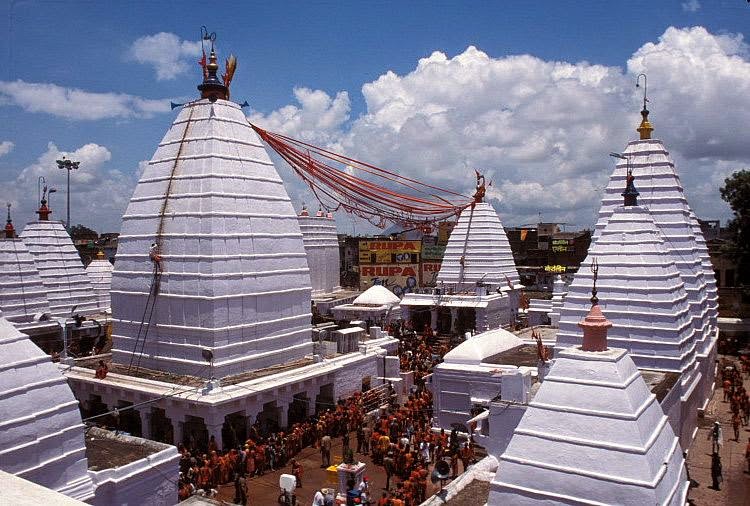Jyotirlinga or Jyotirling or Jyotirlingam, 12 jyotirling name and places in india
The twelve important Hindu temples in India dedicated to Lord Shiva are those with the Jyotirlinga or Jyotirlingam. These 12 temples are known as Dwadash Jyotirlingam or Jyotirlinga. The twelve temples attract millions of Hindu devotees and the most important common festival observed in these temples is the Maha Shivaratri or Shivratri.
Jyotirlingam means 'the linga of light' - the Shivalinga is in the symbolic form of a stone tinctured with a cycle of light. There are numerous legends associated with the origin of Jyotirlinga. It is believed that Lord Shiva for the first time appeared in the form of Jyotirlinga. The Jyotirlinga is an attempt by humans to give a form to the formless Brahman.
There are Twelve (12) temples called Jyotirlingas dedicated to Lord Eshwara in the form of Shiva Lingas. These temples are situated across India and are considered very sacred by Hindus. There is a belief that, all these twelve Jyothirlingas are to be visited in the month of November-December (Kartika Masam). Below are brief details of each Jyotirlinga.
1) Somnath : Somnath is located at Prabhas Patan in Saurashtra in Gujarat.
2) Rameshwaram : This vast temple in the island of Rameswaram, in Southern Tamilnadu enshrines Ramalingeswarar.
3) Srisailam : Srisailam new Kurnool enshrines Mallikarjuna in an ancient temple rich in architectural and sculptural wealth.
4) Ghrishneshwar : Jyotirlinga shrine, in Aurangabad Maharashtra, is located near the rock-cut temples of Ellora.
5) Ujjain : The ancient and historic city of Ujjain or Avanti in Madhya Pradesh is home to the Jyotirlinga shrine of Mahakaleshwar.
6) Varanasi : Varanasi - The most celebrated pilgrimage site in India. The Vishwanath temple in Banaras in Uttar Pradesh is the goal of the thousands of pilgrims that visit this ancient city.
7) Dwarka : Dwarka (Nageshvara Jyotirlinga), in Gujrat, is one of the 12 Jyotirlinga shrines of Shiva.
8) Bhimasankar : Bhimasankar is located in the Sahyadri hills of Maharashtra, accessed from Pune.
9) Trimbakeshwar : The origin of the river Godavari is intimately linked with this Jyotirlinga shrine near Nasik in Maharashtra.
10) Omkareshwar : Omkareshwar, an island in the course of the river Narmada in Madhya Pradesh, is home to the Omkareshwar Jyotirlinga shrine and the Amareshwar temple.
11) Vaidyanath : Vaidyanath is located in the Santal Parganas area of Bihar.
12) Kedarnath : Kedarnath nestled in the snow clad Himalayas. It is accessible only on foot, six months in a year.
The twelve important Hindu temples in India dedicated to Lord Shiva are those with the Jyotirlinga or Jyotirlingam. These 12 temples are known as Dwadash Jyotirlingam or Jyotirlinga. The twelve temples attract millions of Hindu devotees and the most important common festival observed in these temples is the Maha Shivaratri or Shivratri.
Jyotirlingam means 'the linga of light' - the Shivalinga is in the symbolic form of a stone tinctured with a cycle of light. There are numerous legends associated with the origin of Jyotirlinga. It is believed that Lord Shiva for the first time appeared in the form of Jyotirlinga. The Jyotirlinga is an attempt by humans to give a form to the formless Brahman.
There are Twelve (12) temples called Jyotirlingas dedicated to Lord Eshwara in the form of Shiva Lingas. These temples are situated across India and are considered very sacred by Hindus. There is a belief that, all these twelve Jyothirlingas are to be visited in the month of November-December (Kartika Masam). Below are brief details of each Jyotirlinga.
1) Somnath : Somnath is located at Prabhas Patan in Saurashtra in Gujarat.
2) Rameshwaram : This vast temple in the island of Rameswaram, in Southern Tamilnadu enshrines Ramalingeswarar.
3) Srisailam : Srisailam new Kurnool enshrines Mallikarjuna in an ancient temple rich in architectural and sculptural wealth.
4) Ghrishneshwar : Jyotirlinga shrine, in Aurangabad Maharashtra, is located near the rock-cut temples of Ellora.
5) Ujjain : The ancient and historic city of Ujjain or Avanti in Madhya Pradesh is home to the Jyotirlinga shrine of Mahakaleshwar.
6) Varanasi : Varanasi - The most celebrated pilgrimage site in India. The Vishwanath temple in Banaras in Uttar Pradesh is the goal of the thousands of pilgrims that visit this ancient city.
7) Dwarka : Dwarka (Nageshvara Jyotirlinga), in Gujrat, is one of the 12 Jyotirlinga shrines of Shiva.
8) Bhimasankar : Bhimasankar is located in the Sahyadri hills of Maharashtra, accessed from Pune.
9) Trimbakeshwar : The origin of the river Godavari is intimately linked with this Jyotirlinga shrine near Nasik in Maharashtra.
10) Omkareshwar : Omkareshwar, an island in the course of the river Narmada in Madhya Pradesh, is home to the Omkareshwar Jyotirlinga shrine and the Amareshwar temple.
11) Vaidyanath : Vaidyanath is located in the Santal Parganas area of Bihar.
12) Kedarnath : Kedarnath nestled in the snow clad Himalayas. It is accessible only on foot, six months in a year.











.jpg)






















.jpg)
.jpg)
.jpg)






.jpg)











